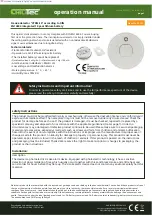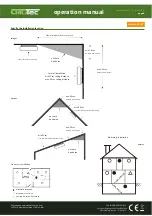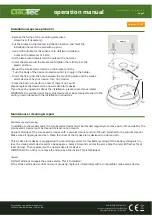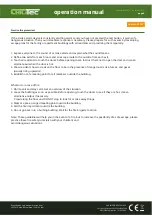
operation manual
Status: 04/2021 - Version 1.01
Page 2
Item No. 21197
Important safety information
1. Press the test button to test the smoke alarm function. Do not use any other test method. Test the smoke alarm
every week to ensure that it is operating properly.
2. If the smoke alarm device triggers an alarm and you are sure that it is not really an emergency, open the windows
or fan the air around the smoke alarm device, the air is swirled, the alarm deactivates .. Remove the battery is not, the
battery must always be inserted.
3. Observe and follow all local, regional, and national electrical and building codes for installation.
4. This smoke alarm device is only intended for use in a room in an apartment or house. In multi-family houses, each
individual residential unit (or most of the rooms) should have its own smoke alarm device. Do not install the device in
unoccupied buildings. In addition, this smoke alarm device is no substitute for a complete warning, signaling or alarm
system.
5. Install a smoke alarm device in every room and on every level of the house (except the kitchen). For many reasons it
can happen that smoke or smoke does not reach the smoke alarm device. For example, if a fire breaks out in a remote
part of the house, on another floor, in a chimney, or on the other side of a closed door, wall, or roof, the smoke may
not reach the smoke alarm in time and, as a result, may not be able to reach the residents alert. A smoke alarm device
can only immediately detect a fire in the area or room in which it is installed.
6. The smoke alarm may not alert everyone in the family every time. The alarm tone is very loud to alert people to a
potential hazard. Under certain circumstances, however, a member may not hear the alarm (e.g. due to outside or
inside noise or deep sleepers, drug or alcohol consumption, poor hearing, etc.). If you suspect that this smoke alarm
device is not alarming a member of the family, install special smoke alarm devices. Every resident must hear the
alarm and be able to respond quickly to reduce the risk of damage, injury, or death from fire. If a member hears
poorly, install special smoke alarms with signal lights or vibrating devices to alert residents.
7. Smoke alarm devices can only trigger an alarm if they detect smoke, smoke or combustion particles in the air. They
don't see any heat, flames or gases. This smoke alarm device is designed in such a way that it gives an acoustic
warning of a developing fire. However, many fires are rapid - burning, explosive, intentional, or caused by
carelessness or safety hazards. In such situations, the smoke may not reach the device FAST ENOUGH and cannot
guarantee a safe escape.
8. Smoke alarms have restrictions. This smoke alarm does not provide protection if misused and does not serve as a
guarantee that life or property will be protected from fire. Smoke alarms are not a substitute for insurance.
Homeowners and renters should insure their life and property. In addition, it is possible that the smoke alarm device
fails at any time, because this is also a technical electronic device. For this reason, you must test the smoke alarm
device weekly and replace the device at least every 10 years.
Reproduction only with permission from
ChiliTec GmbH, Bäckerberg 12, 38165 Lehr
EAR (WEEE): DE25841852
LUCID Packaging Act: DE5562476395648
GRS (UBA register) no .: 21003466


























